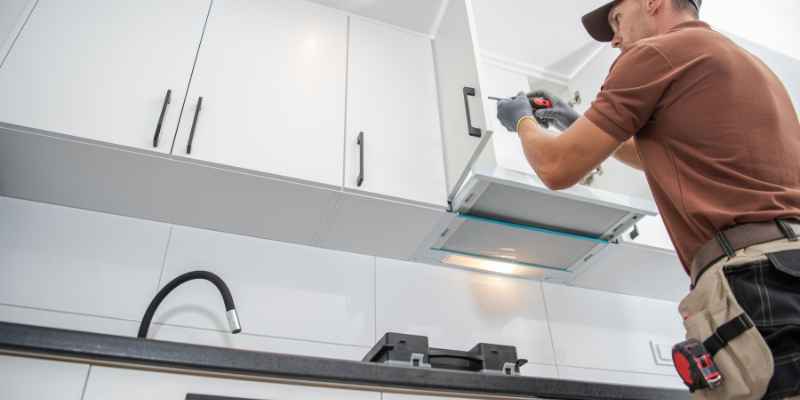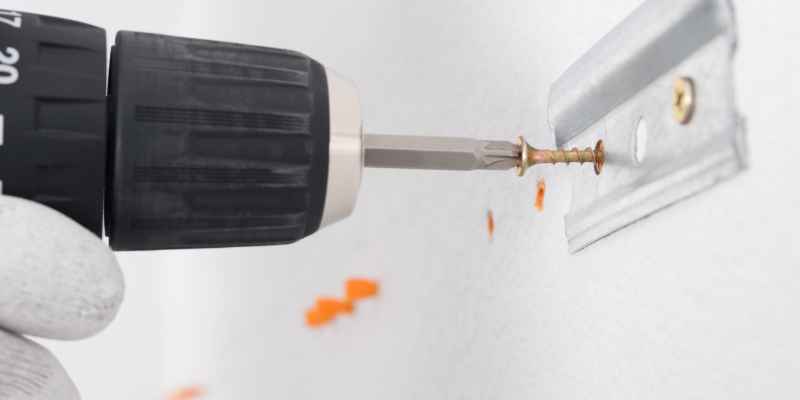The best type of screws to use for hanging cabinets are cabinet screws, which have a larger head that bears down on the cabinet’s hanging strip/rail for a sturdy installation. GRK cabinet screws are a popular and reliable choice for this purpose.
Other viable options include deck screws and Phillips head screws with built-in washers. When it comes to installing cabinets, using the right screws is crucial for ensuring a secure and long-lasting installation. The wrong type of screw can compromise the structural integrity of the cabinet and lead to safety hazards.
This guide provides information on the best types of screws to use for cabinets, including the popular GRK cabinet screws. Keep reading to learn about the differences between drywall screws and cabinet screws and factors to consider when choosing the right screws for your cabinet installation.
Types Of Screws For Cabinets
When it comes to installing cabinets, it is important to use the right screws. Cabinet screws, also known as washer-head or button-head screws, are ideal for securing kitchen wall cabinets to the wall. GRK screws are a popular and strong option for this purpose.
Other factors to consider include finish options and screw size.
When it comes to installing cabinets, selecting the right screws can make all the difference. In this article, we’ll take a look at the most popular types of screws for cabinets and their characteristics.
Drywall Screws vs Cabinet Screws
Drywall screws are designed specifically for drywall installation, whereas cabinet screws are produced for mounting cabinets on walls. Cabinet screws are sturdier and thicker than drywall screws, capable of supporting the weight of cabinet units. Unlike drywall screws, they have a larger head, normally either a washer-head or a button-head, which aids in setting the screw flush with the surface.
Washer-Head Screws vs Button-Head Screws
Washer-head screws feature a flat top with a thin upper rim and a larger, spherical base. The base is meant to sit on the cabinet’s mounting bracket, ensuring even pressure distribution. Button-head screws, on the other hand, are cylindrical and have a flat head with a smaller diameter than the rest of the screw. They are ideal for aesthetic reasons since they attach flush with the cabinet surface without protruding. The choice of which to use depends on the application.
Deck Screws
Deck screws can be used in place of cabinet screws for wall-mounted cabinets. They’re corrosion-resistant, designed to endure harsh outdoor environments, and can support heavy loads. Their threads run along the entire length of the screw, providing extra stability and facilitating easy installation.
GRK Screws
GRK screws differ from regular cabinet screws in various ways. They contain a multi-purpose head that can serve as either a washer-head or a button-head, reducing the need to purchase separate screws. They also have cutting threads that reduce torque, allowing for a quicker, smoother installation. Their increased thread engagement provides a secure grip and prevents stripping, making them a reliable choice for heavy cabinets.
In conclusion, selecting the right screws for cabinet installation is crucial in ensuring the safety and longevity of your cabinets. Consider the type of application, load capacity, and desired aesthetic when choosing the appropriate screws. The above types of screws for cabinets provide the best options for a successful installation.

Factors To Consider When Choosing Screws For Cabinets
Choosing the right screws for cabinets is important to ensure they are securely installed. Consider factors such as screw size, head type, material, and finish. GRK screws are a popular choice due to their strength and availability in stores.
Installing cabinets is not something you should take lightly, and neither is choosing the right screws for the job. From the material of the cabinets to the load capacity, there are various factors to consider to ensure you get the right screws for your cabinets. In this post we will dive into the most important factors that you need to consider when choosing screws for cabinets.
Cabinet Material
Different types of cabinets require different types of screws. For instance, cabinets made of MDF, particleboard, or softwood require screws with coarse threads. This is because the coarse threads grip the material more securely, preventing the screw from becoming loose. On the other hand, hardwood cabinets require screws with fine threads because hardwood is denser and stronger. In summary, when choosing screws for cabinets, consider the type of cabinet material and choose a screw that is best suited for that material.
Screw Length and Width
The length and width of the screw are also important factors to consider. When it comes to length, the screw should be long enough to fully penetrate the cabinet and the wall or stud behind it. The general rule of thumb is that the screw should be two-thirds the length of the material it’s being installed in. As for width, the screw should be of a diameter that provides strong support and prevents the cabinet from becoming loose. In summary, make sure to choose screws with the right length and width to ensure a secure installation.
Hanging Strips or Rails
Most cabinets have hanging strips or rails that support the weight of the cabinet. When choosing screws for cabinets with hanging strips or rails, it’s important to use screws that have a larger diameter head. The larger head provides more surface area to bear the weight of the cabinet and prevents the screw from pulling through the rail. In summary, consider the type of hanging strips or rails on your cabinets and choose screws with an appropriate head size.
Load Capacity
Lastly, when choosing screws for cabinets, it’s essential to consider the load capacity of the screws. In simple terms, load capacity refers to the amount of weight that the screw can support without breaking or causing damage to the cabinet. Make sure that the screw’s load capacity is suitable for the load-bearing capacity of your cabinets. If the screws aren’t strong enough for the weight of the cabinet, it can cause damage to the cabinet or even lead to a potentially hazardous situation. In summary, ensure that the screws you choose can handle the weight of your cabinets to prevent any mishap.
In conclusion, choosing the right screws for cabinets is crucial for a secure and safe installation. By considering the factors discussed above, you can choose screws that are best suited for your cabinets and provide a strong and durable installation.
Best Screws For Installing Cabinets
When it comes to installing cabinets, cabinet screws are specifically made for this purpose. Cabinet screws are known for their large heads that provide strength and support when securing the cabinets onto the wall or hanging strip/rail. GRK Cabinet Screws are an ideal choice with their durability and are readily available at stores.
When it comes to installing cabinets, it’s important to use the right screws for the job. The type and size of screws you use can affect the stability of the cabinets and prevent any accidents from happening. So, what are the best screws for installing cabinets? In this post, we’ll look at four different types of screws that are commonly used for cabinet installation: GRK Cabinet Screws, Rockler Centerline Flat Head Phillips Screws, Satin Nickel Phillips Head Hinge Screw Set, and McFeely’s Screws.
GRK Cabinet Screws
GRK Cabinet Screws are designed specifically for cabinet installation. They have a self-tapping design, which means they can easily drive into wood without pre-drilling. The built-in washer head helps to distribute the load, making for a secure installation that won’t loosen over time. GRK Cabinet Screws come in a range of sizes to fit any cabinet installation needs.
Rockler Centerline Flat Head Phillips Screws
Rockler Centerline Flat Head Phillips Screws are another popular choice for cabinet installation. They feature a flat head that sits flush with the cabinet surface, creating a neat and tidy finish. The Phillips head makes them easy to install with a standard screwdriver.
Satin Nickel Phillips Head Hinge Screw Set
If you’re installing cabinet hinges, the Satin Nickel Phillips Head Hinge Screw Set is a great option. These screws come in a set that includes both #6 x 5/8″ and #6 x 1/2″ screws, which are the most common sizes for hinge installation. The satin nickel finish adds a touch of elegance to your installation.
McFeely’s Screws
McFeely’s Screws are another popular option for cabinet installation. These screws come in a variety of types and sizes, including washer head and pan head. They have a sharp point that allows them to easily penetrate wood without splintering. McFeely’s Screws are also designed with a coarse thread that provides excellent holding power.
In conclusion, when it comes to installing cabinets, it’s important to choose the right screws for the job. The four types of screws we’ve looked at here – GRK Cabinet Screws, Rockler Centerline Flat Head Phillips Screws, Satin Nickel Phillips Head Hinge Screw Set, and McFeely’s Screws – are all great options to ensure a secure and stable installation. By using the right screws and following the manufacturer’s instructions, you can ensure your cabinets will stay in place for years to come.
How To Drill Pilot Holes And Attach Cabinets
When it comes to attaching cabinets, it’s important to choose the right screws for the job. Cabinet screws, also known as washer-head or button-head screws, are designed to securely fix kitchen cabinets to the wall, using their larger head to provide additional stability compared to drywall screws.
The GRK cabinet screw is a popular choice due to its strength and reliability.
When it comes to installing cabinets, it’s important to use the right screws for the job. Cabinet screws, which can also be called washer-head screws or button-head screws, are specifically designed to hold kitchen wall cabinets securely in place. The larger head on these screws helps to distribute weight and prevent cabinets from pulling away from the wall. In this article, we’ll take a look at how to drill pilot holes and attach cabinets using these special screws.
Countersink Bits
Before attaching cabinets, it’s important to use a countersink bit to create a space for the screw head to sit flush with the surface of the wood. This will not only improve the appearance of the cabinets but will also prevent the screw head from protruding and potentially causing damage. Countersink bits come in a variety of sizes and can be adjusted to match the thickness of the screw being used.
Drill Settings
When drilling pilot holes, it’s important to choose the right drill setting to avoid damaging the wood or splitting the material. A low speed setting is typically recommended, along with a drill bit that matches the size of the screw being used. It’s also important to apply steady pressure and avoid widening the pilot hole beyond the size of the screw. This will ensure a tight fit and prevent the screw from loosening over time.
Attaching Cabinets Side By Side
When installing cabinets side by side, it’s important to secure them to one another in addition to the wall. This will keep the cabinets level and prevent them from shifting over time. To attach cabinets side by side, use a cabinet screw to drill through the frame of one cabinet and into the adjoining frame. Use a level to ensure that the cabinets are straight before drilling. Repeat this process for each connection point between the cabinets.
In conclusion, using the right screws and pilot holes is crucial when installing cabinets. By using the proper tools and techniques, you can ensure that your cabinets are securely attached to the wall and to one another.

Frequently Asked Questions On What Screws To Use For Cabinets
What Size Screws Do I Use To Hang Cabinets?
To hang cabinets, use cabinet screws, also known as washer-head or button-head screws. In general, screws that are 2 ½ to 3 inches in length are appropriate for most cabinets. GRK screws are a popular choice due to their strength.
Deck screws can also be used but are typically coated and not as strong as cabinet screws.
What Are The Best Screws For Built In Cabinets?
The best screws for built-in cabinets are cabinet screws, also known as washer-head or button-head screws. These screws have a larger head which bears down on the cabinet’s hanging strip/rail, ensuring a sturdy installation. GRK screws are a good option, as they offer more strength than drywall screws.
Other options include deck screws and pan head Phillips cabinet hardware mounting screws.
What Screws Do You Need To Fix Kitchen Cabinets Together?
The best screws to fix kitchen cabinets together are cabinet screws, which have larger heads to bear down on the cabinet’s hanging strip/rail, ensuring a sturdy installation. Some recommended brands include GRK and Rockler. Other options include washer-head screws and button-head screws.
Deck screws and drywall screws should be avoided.
What Do You Use To Screw Cabinets Together?
Cabinet screws, also known as washer-head or button-head screws, are best for securing kitchen wall cabinets to the wall. The larger head type bears down on the cabinet’s hanging strip/rail to ensure a sturdy installation. GRK screws are a popular choice for their strength.
Other types of screws that may work include deck screws.
Conclusion
It is crucial to choose the appropriate screws when installing cabinets to ensure stability and longevity. The best screws for cabinet installations are cabinet screws, which are designed specifically for this purpose. Many top-rated options, such as GRK cabinet screws and Rockler Centerline mounting screws, are readily available in stores.
Considering the size, screw head, and finish of the screw will also help you make the right choice. Ultimately, investing in high-quality screws for cabinet installation is essential to avoid any potential damage or risks in the long run.


